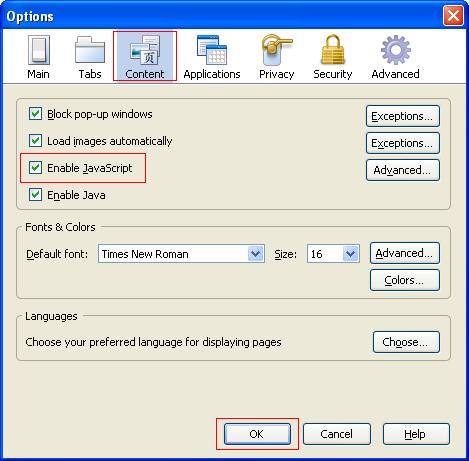- Table of Contents
-
- H3C WX Series Access Controllers Web-Based Configuration Guide(R3308 R2308)-6W107
- 00-Preface
- 01-About the WX Series Access Controllers Web Configuration Guide
- 02-Quick Start
- 03-Web Overview
- 04-Summary
- 05-Device
- 06-Network
- 07-AP Configuration
- 08-Wireless Service
- 09-WLAN Roaming Configuration
- 10-Radio Configuration
- 11-Authentication
- 12-Security
- 13-QoS configuration
- 14-Advanced Settings
- 15-Stateful Failover Configuration
- Related Documents
-
| Title | Size | Download |
|---|---|---|
| 03-Web Overview | 288.26 KB |
Contents
Logging in to the Web interface
Logging out of the Web interface
Introduction to the Web interface
Introduction to the Web-based NM functions
Failure to access the device through the Web interface
The device provides Web-based configuration interfaces for visual device management and maintenance.
Figure 1 Web-based network management operating environment

Logging in to the Web interface
You can use the following default settings to log in to the Web interface through HTTP:
· Username—admin
· Password—admin
· IP address of VLAN-interface 1 of the device—192.168.0.100.
To log in to the Web interface of the device from a PC:
1. Connect the Ethernet port of the device to the PC by using a crossover Ethernet cable.
By default, all ports belong to VLAN 1.
2. Configure an IP address for the PC and make sure that the PC and the device can reach each other.
For example, assign the PC an IP address (for example, 192.168.0.2) within the network segment 192.168.0.0/24 (except for 192.168.0.100).
3. Open the browser and input the login information:
a. Type the IP address http://192.168.0.100 in the address bar and press Enter.
The login page of the Web interface (see Figure 2) appears.
b. Enter the username and password admin, and the verification code, select the language (English and Chinese are supported at present), and click Login.
Figure 2 Login page of the Web interface

c. After you click Login, you will enter the following page. Select a country/region code from the Country/Region list, and click Apply.
Figure 3 Selecting a country/region code

The PC where you configure the device is not necessarily the Web-based network management terminal. A Web-based network management terminal is a PC (or another terminal) used to log in to the Web interface and is required to be reachable to the device.
After logging in to the Web interface, you can create a new user and configure the IP address of the interface connecting the user and the device.
If you click the verification code displayed on the Web login page, you can get a new verification code.
Up to 24 users can concurrently log in to the device through the Web interface.
Logging out of the Web interface
As shown in Figure 4, click Logout in the upper-right corner of the Web interface to quit Web-based network management.
The system does not save the current configuration before you log out of the Web interface. H3C recommends you to save the current configuration before logout.
|
CAUTION: A logged-in user cannot automatically log out by directly closing the browser. |
Introduction to the Web interface
The Web interface comprises three parts: navigation tree, title area, and body area.
Figure 4 Web-based configuration interface
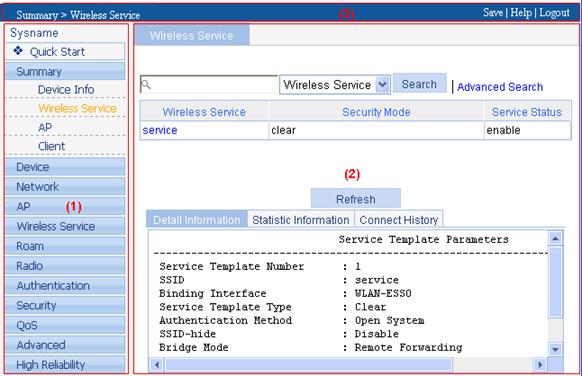
|
(1) Navigation area |
(2) Body area |
· Navigation area—Organizes the Web-based NM function menus in the form of a navigation tree, where you can select function menus as needed. The result is displayed in the body area. The Web network management functions not supported by the device are not displayed in the navigation area.
· Body area—The area where you can configure and display a function.
· Title area—On the left, displays the path of the current configuration interface in the navigation area; on the right, provides the Save button to quickly save the current configuration, the Help button to display the Web related help information, and the Logout button to log out of the Web interface.
Web user level
Web user levels, ranging from low to high, are visitor, monitor, configure, and management. A user with a higher level has all the operating rights of a user with a lower level.
· Visitor—Users of this level can perform the ping and traceroute operations, but they can neither access the device data nor configure the device.
· Monitor—Users of this level can only access the device data but cannot configure the device.
· Configure—Users of this level can access data from the device and configure the device, but they cannot upgrade the host software, add/delete/modify users, or back up/restore the application file.
· Management—Users of this level can perform any operations for the device.
Introduction to the Web-based NM functions
|
|
NOTE: · Support for the configuration items depends on the device model. For more information, see "Feature matrixes." · A user level in Table 1 indicates that users of this level or users of a higher level can perform the corresponding operations. |
Table 1 Description for Web-based NM functions
|
Function menu |
Description |
User level |
||||
|
Quick Start |
Perform quick configuration of the device. |
Configure |
||||
|
Summary |
Device Info |
Display and refresh system resource state, device information, device interface information, and recent system operation logs. |
Monitor |
|||
|
Wireless Service |
Display the information of the queried WLAN service, including the detailed information, statistics, and connection history. |
Monitor |
||||
|
AP |
Display the information of the queried AP, including wireless service, connection history, radio, and detailed information. |
Monitor |
||||
|
Reboot an AP. |
Configure |
|||||
|
Client |
Display the detailed information, statistics, and roaming information of the client. |
Monitor |
||||
|
Clear statistics of the client, disconnect the connection, and add the client into the blacklist. |
Configure |
|||||
|
Device |
License |
License |
Display license information. |
Monitor |
||
|
Add licenses. |
Configure |
|||||
|
Enhanced License |
Display enhanced license information. |
Monitor |
||||
|
Register enhanced licenses. |
Configure |
|||||
|
Basic |
System Name |
Display and configure the system name. |
Configure |
|||
|
Web Idle Timeout |
Display and configure the idle timeout period for a logged-in user. |
Configure |
||||
|
Device Maintenance |
Software Upgrade |
Upload the file to be upgraded from the local host to upgrade the system software. |
Management |
|||
|
Reboot |
Reboot the device. |
Management |
||||
|
Diagnostic Information |
Generate a diagnostic information file, view the file, or save the file to the local host. |
Management |
||||
|
System Time |
System Time |
Display the system date and time. |
Monitor |
|||
|
Manually set the system time. |
Configure |
|||||
|
Net Time |
Set local and external clock sources and system time zone. |
Monitor |
||||
|
Set the network time. |
Configure |
|||||
|
Syslog |
Loglist |
Display and refresh system logs. |
Monitor |
|||
|
Clear system logs. |
Configure |
|||||
|
Loghost |
Display and configure the loghost. |
Configure |
||||
|
Log Setup |
Display and configure the buffer capacity, and refresh interval for displaying system logs. |
Configure |
||||
|
Configuration |
Backup |
Back up the configuration file for the next startup to the host of the current user. |
Management |
|||
|
Restore |
Upgrade the configuration file on the host of the current user to the device for the next startup. |
Management |
||||
|
Save |
Save the current configuration to the configuration file for the next startup. |
Configure |
||||
|
Initialize |
Restore the system to factory defaults. |
Configure |
||||
|
File management |
Manage files on the device, including displaying file list, downloading a file, uploading a file, removing a file, and setting the main boot file. |
Management |
||||
|
Interface |
Display interface information and statistics. |
Monitor |
||||
|
Create, modify, and delete an interface, and clear interface statistics. |
Configure |
|||||
|
Port Mirroring |
Summary |
Display the configuration information of a port mirroring group. |
Monitor |
|||
|
Add |
Create a port mirroring group. |
Configure |
||||
|
Remove |
Remove a port mirroring group. |
Configure |
||||
|
Modify Port |
Configure ports for a mirroring group. |
Configure |
||||
|
Users |
Summary |
Display brief information of FTP and Telnet users. |
Monitor |
|||
|
Super Password |
Configure the password for a lower-level user to switch from the current access level to the management level. |
Management |
||||
|
Create |
Create an FTP or Telnet user. |
Management |
||||
|
Modify |
Modify FTP or Telnet user information. |
Management |
||||
|
Remove |
Remove an FTP or a Telnet user. |
Management |
||||
|
Switch To Management |
Switch the current user level to the management level. |
Monitor |
||||
|
SNMP |
Setup |
Display and refresh SNMP configuration and statistics information. |
Monitor |
|||
|
Configure SNMP. |
Configure |
|||||
|
Community |
Display SNMP community information. |
Monitor |
||||
|
Create, modify, and delete an SNMP community. |
Configure |
|||||
|
Group |
Display SNMP group information. |
Monitor |
||||
|
Create, modify, and delete an SNMP group. |
Configure |
|||||
|
User |
Display SNMP user information. |
Monitor |
||||
|
Create, modify, and delete an SNMP user. |
Configure |
|||||
|
Trap |
Display the status of the SNMP trap function and information about target hosts. |
Monitor |
||||
|
Enable or disable the SNMP trap function, or create, modify, and delete a target host. |
Configure |
|||||
|
View |
Display SNMP view information. |
Monitor |
||||
|
Create, modify, and delete an SNMP view. |
Configure |
|||||
|
Loopback |
Perform the loopback test on Ethernet interfaces. |
Configure |
||||
|
Network |
MAC |
MAC |
Display MAC address information. |
Monitor |
||
|
Create or remove MAC addresses. |
Configure |
|||||
|
Setup |
Display and configure MAC address aging time. |
Configure |
||||
|
VLAN |
VLAN |
Display all VLANs on the device and information about their member ports. |
Monitor |
|||
|
Create, modify, and delete VLANs. |
Configure |
|||||
|
Port |
Display VLANs to which a port on the device belongs. |
Monitor |
||||
|
Modify the VLANs to which a port belongs. |
Configure |
|||||
|
ARP Management |
ARP Table |
Display ARP table information. |
Monitor |
|||
|
Add, modify, or delete an ARP entry. |
Configure |
|||||
|
Gratuitous ARP |
Display configuration information of gratuitous ARP. |
Monitor |
||||
|
Configure gratuitous ARP. |
Configure |
|||||
|
ARP Anti-Attack |
ARP Detection |
Display the configuration information of ARP detection. |
Monitor |
|||
|
Configure ARP detection. |
Configure |
|||||
|
Advanced Configuration |
Display the configuration information of source MAC address based ARP attack detection, ARP active acknowledgement, and ARP packet source MAC address consistency check. |
Monitor |
||||
|
Configure source MAC address based ARP attack detection, ARP active acknowledgement, and ARP packet source MAC address consistency check. |
Configure |
|||||
|
IGMP Snooping |
Basic |
Display global IGMP Snooping configuration information and the IGMP Snooping configuration information in a VLAN, and view the IGMP Snooping multicast entry information. |
Monitor |
|||
|
Configure IGMP Snooping globally and in a VLAN. |
Configure |
|||||
|
Advance |
Display the IGMP Snooping configuration information on a port. |
Monitor |
||||
|
Configure IGMP Snooping on a port. |
Configure |
|||||
|
IPv4 Routing |
Summary |
Display the IPv4 active route table. |
Monitor |
|||
|
Create |
Create an IPv4 static route. |
Configure |
||||
|
Remove |
Delete the selected IPv4 static routes. |
Configure |
||||
|
IPv6 Routing |
Summary |
Display the IPv6 active route table. |
Monitor |
|||
|
Create |
Create an IPv6 static route. |
Configure |
||||
|
Remove |
Delete the selected IPv6 static routes. |
Configure |
||||
|
DHCP |
DHCP Server |
Display the DHCP service status, the DHCP address pool information, the DHCP server status on an interface, and addresses in use. |
Monitor |
|||
|
Set the DHCP service status, add, modify, or delete a DHCP address pool, and modify the DHCP server status on an interface. |
Configure |
|||||
|
DHCP Relay |
Display the status of a DHCP service and advanced configuration information of DHCP relay, display information of a DHCP group, and status of the DHCP relay agent on an interface, and view the DHCP relay user information. |
Monitor |
||||
|
Configure the status of a DHCP service and advanced configuration information of DHCP relay, add or delete a DHCP group, and modify the status of the DHCP relay agent on an interface. |
Configure |
|||||
|
DHCP Snooping |
Display the status of the DHCP Snooping function, and the trusted and untrusted attributes of a port, and view the DHCP Snooping user information. |
Monitor |
||||
|
Configure the status of the DHCP Snooping function, and modify the trusted and untrusted attributes of a port. |
Configure |
|||||
|
DNS |
Static |
Display, create, modify, or delete a static host name-to-IP address mapping. |
Configure |
|||
|
Dynamic |
Display and configure related parameters for dynamic domain name resolution. Display, create, or delete an IP address and the domain name suffix. |
Configure |
||||
|
Service |
Display the states of the services: enabled or disabled. |
Configure |
||||
|
Specify whether to enable various services, and set related parameters. |
Management |
|||||
|
Diagnostic Tools |
IPv4 Ping |
Ping an IPv4 address or host and display the result. |
Visitor |
|||
|
IPv6 Ping |
Ping an IPv6 address or host and display the result. |
Visitor |
||||
|
Trace Route |
Perform trace route operations and display the result. |
Visitor |
||||
|
AP |
AP Setup |
Display AP-related information, including AP name, AP IP address, serial ID, model and status. |
Monitor |
|||
|
Add an AP and modify the AP configuration. |
Configure |
|||||
|
Auto AP |
Display auto AP information after auto AP is enabled, including AP name, model, serial ID and IP address. |
Monitor |
||||
|
Enable auto AP. |
Configure |
|||||
|
AP Group |
Display AP group information. |
Monitor |
||||
|
Create and configure an AP group. |
Configure |
|||||
|
WLAN Service |
Access Service |
Display an access service, including security type, detailed information, service status and binding status. |
Monitor |
|||
|
Create and configure an access service, map an access service to an AP radio, and add a MAC authentication list. |
Configure |
|||||
|
Mesh Service |
Mesh Service |
Display a mesh service, including its detailed information, status, and binding information. |
Monitor |
|||
|
Create and configure a mesh service, including security settings. |
Configure |
|||||
|
Mesh Policy |
Display mesh policies. |
Monitor |
||||
|
Create and configure a mesh policy. |
Configure |
|||||
|
Global Setup |
Display mesh global setting, including basic setting, mesh DFS, and mesh portal service. |
Monitor |
||||
|
Configure mesh global setting, including basic setting, mesh DFS, and mesh portal service. |
Configure |
|||||
|
Mesh Channel Optimize |
Display radio information and channel switch information in a mesh network. |
Monitor |
||||
|
Configure mesh channel optimization. |
Configure |
|||||
|
Mesh Link Info |
Display mesh link status information. |
Monitor |
||||
|
Monitor mesh link status and refresh mesh link status information. |
Configure |
|||||
|
Mesh Link Test |
Display mesh link test results. |
Monitor |
||||
|
Test mesh links and refresh mesh link test results. |
Configure |
|||||
|
Roam |
Roam Group |
Display a roaming group and its members. |
Monitor |
|||
|
Configure a roaming group and add a group member. |
Configure |
|||||
|
Roam Client |
Display client information, including MAC address, BSSID, VLAN ID, home AC and roaming direction. |
Monitor |
||||
|
Radio |
Radio |
Display radio status, including radio mode and radio status. |
Monitor |
|||
|
Configure radio parameters, including 802.11n settings. |
Configure |
|||||
|
Rate |
Display rate settings. |
Monitor |
||||
|
Configure 802.11n rates, including MCS index. |
Configure |
|||||
|
Channel Scan |
Display channel scanning, including scanning mode, scanning type and scanning interval. |
Monitor |
||||
|
Configure channel scanning, including scanning mode and scanning type. |
Configure |
|||||
|
Calibration |
Operation |
Display or refresh AP status, including channel status, neighbor information, and history information. |
Monitor |
|||
|
Manual calibration |
Configure |
|||||
|
Parameters |
Display basic setup, channel setup and power setup. |
Monitor |
||||
|
Configure channel calibration parameters. |
Configure |
|||||
|
Radio Group |
Display radio group configuration. |
Monitor |
||||
|
Configure a radio group. |
Configure |
|||||
|
Antenna Switch |
Configure the antenna of an AP. |
Configure |
||||
|
Authentication |
802.1X |
Display the global 802.1X information and 802.1X information of a port. |
Monitor |
|||
|
Display the global 802.1X features and 802.1x features of a port. |
Configure |
|||||
|
Portal |
Portal Server |
Display configuration information about the portal server and advanced parameters for portal authentication. |
Monitor |
|||
|
Add and delete a portal server, and modify advanced parameters for portal authentication. |
Configure |
|||||
|
Free Rule |
Display the portal-free rule configuration information. |
Monitor |
||||
|
Add and delete a portal-free rule. |
Configure |
|||||
|
AAA |
Domain Setup |
Display ISP domain configuration information. |
Monitor |
|||
|
Add and remove ISP domains. |
Management |
|||||
|
Authentication |
Display the authentication method configuration information of an ISP domain. |
Monitor |
||||
|
Specify authentication methods for an ISP domain. |
Management |
|||||
|
Authorization |
Display the authorization method configuration information of an ISP domain. |
Monitor |
||||
|
Specify authorization methods for an ISP domain. |
Management |
|||||
|
Accounting |
Display the accounting method configuration information of an ISP domain. |
Monitor |
||||
|
Specify accounting methods for an ISP domain. |
Management |
|||||
|
RADIUS |
Display and add, modify, and delete a RADIUS scheme. |
Management |
||||
|
Local EAP Server |
Display the configuration information of the local EAP service. |
Monitor |
||||
|
Configure the local EAP service. |
Configure |
|||||
|
Users |
Local User |
Display local users' configuration information. |
Monitor |
|||
|
Add, modify, and remove local users. |
Management |
|||||
|
User Group |
Display user groups' configuration information. |
Monitor |
||||
|
Add, modify, and remove user groups. |
Management |
|||||
|
Guest |
Display guest users' configuration information. |
Monitor |
||||
|
Add, modify, and remove guest users. |
Management |
|||||
|
User Profile |
Display user profile configuration information. |
Monitor |
||||
|
Add, modify, remove, enable, and disable user profiles. |
Configure |
|||||
|
Certificate Management |
Entity |
Display information about PKI entities. |
Monitor |
|||
|
Add, modify, and delete a PKI entity. |
Configure |
|||||
|
Domain |
Display information about PKI domains. |
Monitor |
||||
|
Add, modify, and delete a PKI domain. |
Configure |
|||||
|
Certificate |
Display the certificate information of PKI domains and view the contents of a certificate. |
Monitor |
||||
|
Generate a key pair, destroy a key pair, retrieve a certificate, request a certificate, and delete a certificate. |
Configure |
|||||
|
CRL |
Display the contents of the CRL. |
Monitor |
||||
|
Receive the CRL of a domain. |
Configure |
|||||
|
Security |
Rogue detection |
AP Monitor |
Display AP operating mode. |
Monitor |
||
|
Configure AP operating mode. |
Configure |
|||||
|
Rule List |
Display list types for the rogue device detection and the detection rules. |
Monitor |
||||
|
Configure list types for rogue device detection and the rules. |
Configure |
|||||
|
Monitor Record |
Display monitor record of rogue device detection. |
Monitor |
||||
|
Clear monitor record of rogue device detection, and add rogue devices to blacklist. |
Configure |
|||||
|
History Record |
Display rogue device detection history. |
Monitor |
||||
|
Clear history of rogue device detection and add rogue devices to blacklist. |
Configure |
|||||
|
WIDS |
WIDS Setup |
Display IDS configuration. |
Monitor |
|||
|
Configure IDS detection, including flood attack detection, spoofing attack detection, and weak IV detection. |
Configure |
|||||
|
History Record |
Display IDS attack detection history. |
Monitor |
||||
|
Clear history record of IDS attack detection and add the detected devices that initiate attacks to blacklist. |
Configure |
|||||
|
Statistics |
Display statistics of IDS attack detection. |
Monitor |
||||
|
Clear the statistics. |
Configure |
|||||
|
Filter |
Blacklist |
Display dynamic and static blacklists. |
Monitor |
|||
|
Clear dynamic blacklist and static blacklist; enable dynamic blacklist; add entries to the static blacklist. |
Configure |
|||||
|
White List |
Display white list. |
Monitor |
||||
|
Clear white list and add entries to the white list. |
Configure |
|||||
|
Authorized IP |
Summary |
Display the configurations of the authorized IP, the associated IPv4 ACL rule list, and the associated IPv6 ACL rule list. |
Management |
|||
|
Setup |
Configure the authorized IP. |
Configure |
||||
|
User Isolation |
Display, add, modify, and remove user isolation configuration. |
Management |
||||
|
QoS |
Time Range |
Summary |
Display time range configuration information. |
Monitor |
||
|
Add |
Create a time range. |
Configure |
||||
|
Remove |
Delete a time range. |
Configure |
||||
|
ACL IPv4 |
Summary |
Display IPv4 ACL configuration information. |
Monitor |
|||
|
Add |
Create an IPv4 ACL. |
Configure |
||||
|
Basic Setup |
Configure a rule for a basic IPv4 ACL. |
Configure |
||||
|
Advanced Setup |
Configure a rule for an advanced IPv4 ACL. |
Configure |
||||
|
Link Setup |
Create a rule for an Ethernet frame header ACL. |
Configure |
||||
|
Remove |
Delete an IPv4 ACL or its rules. |
Configure |
||||
|
ACL IPv6 |
Summary |
Display IPv6 ACL configuration information. |
Monitor |
|||
|
Add |
Create an IPv6 ACL. |
Configure |
||||
|
Basic Setup |
Configure a rule for a basic IPv6 ACL. |
Configure |
||||
|
Advanced Setup |
Configure a rule for an advanced IPv6 ACL. |
Configure |
||||
|
Remove |
Delete an IPv6 ACL or its rules. |
Configure |
||||
|
Wireless QoS |
Wireless QoS |
Display wireless QoS, including SVP mapping, CAC admission policy, radio EDCA and client EDCA. |
Monitor |
|||
|
Configure wireless QoS, including SVP mapping, CAC admission policy, radio EDCA and client EDCA. |
Configure |
|||||
|
Radio Statistics |
Display radio statistics, including WMM status and detailed radio information. |
Monitor |
||||
|
Display radio statistics, including WMM status and detailed radio information, and clear the radio statistics. |
Configure |
|||||
|
Client Statistics |
Display client statistics, including WMM status and detailed client information. |
Monitor |
||||
|
Display client statistics, including WMM status and detailed client information, and clear the client statistics. |
Configure |
|||||
|
Client Rate Limit |
Display the configured client rate limit information. |
Monitor |
||||
|
Configure and modify client rate limiting mode, direction and rate. |
Configure |
|||||
|
Bandwidth Guarantee |
Display bandwidth settings for different radio types. |
Monitor |
||||
|
Configure bandwidth guarantee settings. |
Configure |
|||||
|
Line Rate |
Summary |
Display line rate configuration information. |
Monitor |
|||
|
Setup |
Configure the line rate. |
Configure |
||||
|
Port Priority |
Display the priority and trust mode of a port. |
Monitor |
||||
|
Modify the priority and trust mode of a port. |
Configure |
|||||
|
Trust Mode |
Display priority trust mode configuration information. |
Management |
||||
|
Configure the priority trust mode. |
Management |
|||||
|
Classifier |
Summary |
Display classifier configuration information. |
Monitor |
|||
|
Add |
Create a class. |
Configure |
||||
|
Setup |
Configure the classification rules for a class. |
Configure |
||||
|
Remove |
Delete a class or its classification rules. |
Configure |
||||
|
Behavior |
Summary |
Display traffic behavior configuration information. |
Monitor |
|||
|
Add |
Create a traffic behavior. |
Configure |
||||
|
Setup |
Configure actions for a traffic behavior. |
Configure |
||||
|
Remove |
Delete a traffic behavior. |
Configure |
||||
|
QoS Policy |
Summary |
Display QoS policy configuration information. |
Monitor |
|||
|
Add |
Create a QoS policy. |
Configure |
||||
|
Setup |
Configure the classifier-behavior associations for a QoS policy. |
Configure |
||||
|
Remove |
Delete a QoS policy or its classifier-behavior associations. |
Configure |
||||
|
Port Policy |
Summary |
Display the QoS policy applied to a port. |
Monitor |
|||
|
Setup |
Apply a QoS policy to a port. |
Configure |
||||
|
Remove |
Remove the QoS policy from the port. |
Configure |
||||
|
Service Policy |
Display the QoS policy applied to a WLAN-ESS port. |
Monitor |
||||
|
Configure the QoS policy applied to a WLAN-ESS port. |
Configure |
|||||
|
Advanced |
Country/Region Code |
Display the country/region code. |
Monitor |
|||
|
Modify the country/region code. |
Configure |
|||||
|
AC Backup |
Setup |
Display the address of the backup AC. |
Monitor |
|||
|
Configure the address of the backup AC. |
Configure |
|||||
|
Status |
Display the status of the AC. |
Monitor |
||||
|
Continuous Transmit |
Display the continuous transmitting mode of an AP. |
Monitor |
||||
|
Switch the continuous transmitting mode of an AP. |
Configure |
|||||
|
Channel Busy Test |
Display channel busy rate test results. |
Monitor |
||||
|
Test busy rate of channels, and output test results. |
Configure |
|||||
|
Load Balancing |
Load Balance |
Display the load balancing mode and the current connection status. |
Monitor |
|||
|
Configure the load balancing mode and refresh the current connection status. |
Configure |
|||||
|
Load Balance Group |
Display load balancing group configuration. |
Monitor |
||||
|
Configure a load balancing group. |
Configure |
|||||
|
AP |
AP Module |
Display the AP version, including the AP model and software version. |
Monitor |
|||
|
Upgrade the software. |
Configure |
|||||
|
Switch to fat AP |
Display the model and IP address of the AP. |
Monitor |
||||
|
Switch to fat AP. |
Configure |
|||||
|
Wireless Location |
Display wireless location settings. |
Monitor |
||||
|
Configure, enable, and disable wireless location. |
Configure |
|||||
|
Wireless Sniffer |
Display wireless sniffer configuration. |
Monitor |
||||
|
Configure, enable, and disable wireless sniffer parameters. |
Configure |
|||||
|
High Reliability |
Stateful Failover |
Display stateful failover information. |
Monitor |
|||
|
Modify stateful failover configuration. |
Configure |
|||||
Common Web interface elements
Common buttons and icons
Table 2 Common buttons and icons
|
Button and icon |
Description |
|
|
Bring the configuration on the current page into effect. |
|
|
Cancel the configuration on the current page, and go to the corresponding display page or device information page. |
|
|
Refresh the information on the current page. |
|
|
Clear all statistics or items in a list. |
|
|
Enter the page for adding an entry. |
|
|
Delete entries on a list. |
|
|
Select all the entries on a list or all ports on a device panel. |
|
|
Clear all the entries on a list or all ports on a device panel. |
|
|
Restore the values of all the entries on the current page to the default. |
|
|
Typically locating at a configuration procedure page of the configuration wizard, it allows you to save the configuration of the current configuration procedure (not bring it into effect) and go to the page of the next configuration procedure. |
|
|
Typically locating at a configuration procedure page of the configuration wizard, it allows you to save the configuration of the current configuration procedure (not bring it into effect) and return to the page of the previous configuration procedure. |
|
|
Typically locating at a configuration procedure page of the configuration wizard, it allows you to bring all configurations into effect. |
|
|
Typically locating at the Operation column of a display page, it allows you to enter the modify page of a corresponding entry so as to display or modify the configurations of the entry. |
|
|
Typically locating at the Operation column of a display page, it allows you to remove an entry. |
Content display by pages
The Web interface can display contents by pages, as shown in Figure 5. You can set the number of entries displayed per page, and view the contents on the first, previous, next, and last pages, or go to any page that you want to check.
Figure 5 Content display by pages
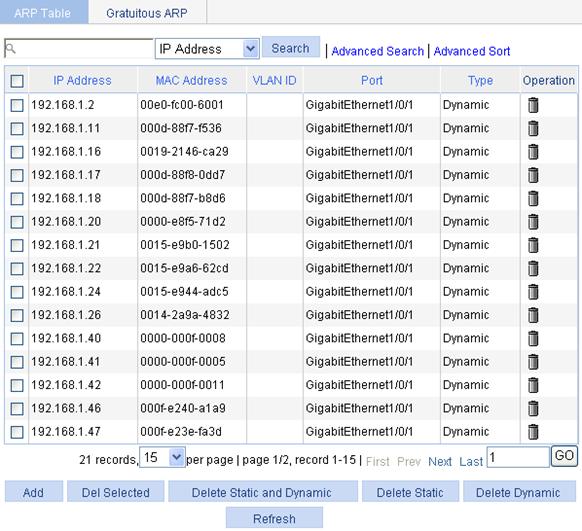
Searching function
· Basic search—As shown in Figure 5, input the keyword in the text box above the list, select a search item from the list and click Search to display the entries that match the criteria. Figure 6 shows an example of searching for entries with 00e0 included in the MAC address.
Figure 6 Basic search function example

· Advanced search—Advanced search function: As shown in Figure 5, you can click the Advanced Search link to open the advanced search page, as shown in Figure 7. Specify the search criteria, and click Apply to display the entries that match the criteria.
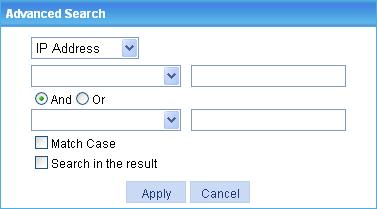
Take the ARP table shown in Figure 5 as an example. If you want to search for the ARP entries with 000f at the beginning of the MAC address, and IP address range being 192.168.1.50 to 192.168.1.59, follow these steps:
1. Click the Advanced Search link, specify the search criteria on the advanced search page as shown in Figure 8, and click Apply. The ARP entries with 000f at the beginning of the MAC address are displayed.
Figure 8 Advanced search function example (I)
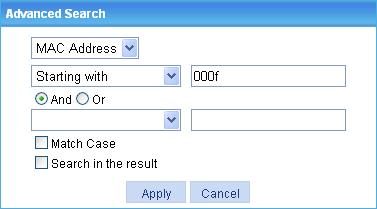
2. Click the Advanced Search link, specify the search criteria on the advanced search page as shown in Figure 9, and click Apply. The ARP entries with 000f at the beginning of the MAC address and IP address range 192.168.1.50 to 192.168.1.59 are displayed as shown in Figure 10.
Figure 9 Advanced search function example (II)
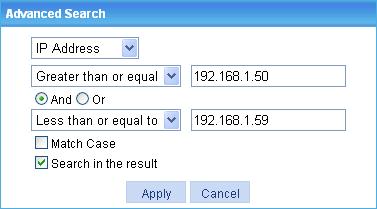
Figure 10 Advanced search function example (III)

Sorting function
The Web interface provides you with the basic functions to display entries in certain orders.
On a list page, you can click the blue heading item of each column to sort the entries based on the heading item you selected. After your clicking, the heading item is displayed with an arrow beside it as shown in Figure 11. The upward arrow indicates the ascending order, and the downward arrow indicates the descending order.
Figure 11 Basic sorting function example (based on IP address in the descending order)
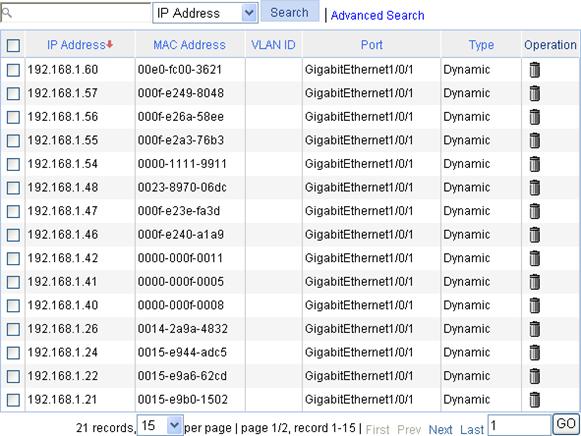
Configuration guidelines
· The Web-based configuration interface supports the operating systems of Windows XP, Windows 2000, Windows Server 2003 Enterprise Edition, Windows Server 2003 Standard Edition, Windows Vista, Linux, and MAC OS.
· The Web-based configuration interface supports the browsers of Microsoft Internet Explorer 6.0 SP2 and higher, Mozilla Firefox 3.0 and higher, Google Chrome 2.0.174.0 and higher.
· The Web-based configuration interface does not support the Back, Next, and Refresh buttons. Using these buttons may result in abnormal display of Web pages.
· The Windows firewall limits the number of TCP connections, so when you use IE to log in to the Web interface, sometimes you may be unable to open the Web interface. To avoid this problem, turn off the Windows firewall before login.
· If the software version of the device changes, clear the cache data on the browser before logging in to the device through the Web interface; otherwise, the Web page content may not be displayed correctly.
· You can display at most 20,000 entries that support content display by pages.
Troubleshooting Web browser
Failure to access the device through the Web interface
Symptom
You can ping the device successfully, and log in to the device through telnet. HTTP is enabled and the operating system and browser version meet the Web interface requirements. However, you cannot access the Web interface of the device.
Analysis
· If you use the Microsoft Internet Explorer, you can access the Web interface only when these functions are enabled: Run ActiveX controls and plug-ins, script ActiveX controls marked safe for scripting and active scripting.
· If you use the Mozilla Firefox, you can access the Web interface only when JavaScript is enabled.
Configuring the Internet Explorer settings
1. Open the Internet Explorer, and then select Tools > Internet Options.
2. Click the Security tab, and then select a Web content zone to specify its security settings.
Figure 12 Internet Explorer setting (I)
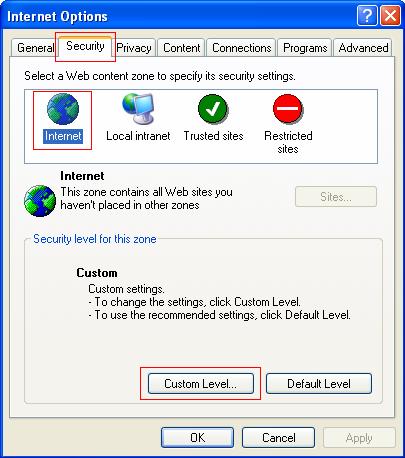
3. Click Custom Level, and a dialog box Security Settings appears.
4. As shown in Figure 13, set the enable these functions: Run ActiveX controls and plug-ins, script ActiveX controls marked safe for scripting and active scripting.
Figure 13 Internet Explorer setting (II)
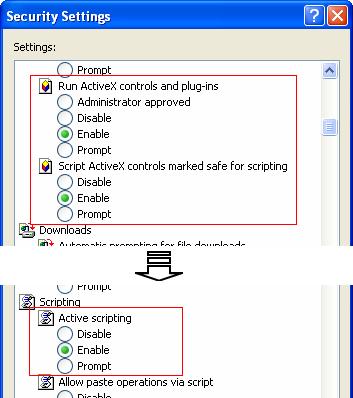
5. Click OK in the Security Settings dialog box.
Configuring Firefox Web browser settings
1. Open the Firefox Web browser, and then select Tools > Options.
2. Click the Content tab, select Enable JavaScript, and click OK.
Figure 14 Firefox Web browser setting
